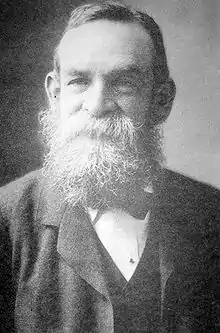William Forsell Kirby
William Forsell Kirby (14 January 1844 – 20 November 1912[1]) was an English entomologist and folklorist.

Life
He was born in Leicester. He was the eldest son of Samuel Kirby, who was a banker. He was educated privately, and became interested in butterflies and moths at an early age. The family moved to Brighton, where he became acquainted with Henry Cooke, Frederick Merrifield and J. N. Winter.[2] He published the Manual of European Butterflies in 1862.
In 1867 he became a curator in the Museum of the Royal Dublin Society, and produced a Synonymic Catalogue of Diurnal Lepidoptera (1871; Supplement 1877).
In 1879 Kirby joined the staff of the British Museum (Natural History) as an assistant, after the death of Frederick Smith. He published a number of catalogues, as well as Rhopalocera Exotica (1887–1897) and an Elementary Text-book of Entomology. He also did important work on orthopteroid insects including a three volume Catalogue of all known species (1904, 1906, 1910). He retired in 1909.
Kirby had a wide range of interests, knew many languages and fully translated Finland's national epic, the Kalevala, from Finnish into English. Kirby's translation, which carefully reproduces the Kalevala meter, was a major influence on the writings of J.R.R. Tolkien, who first read it in his teens. Kirby also provided many footnotes to Sir Richard Burton's translation of the Arabian Nights.[2]
A short biography of Kirby, with particular reference to his work on phasmids, was published by P. E. Bragg in 2007.[3]
Evolution
Kirby was an advocate of theistic evolution. In his book Evolution and Natural Theology, he argued that evolution and theism are compatible. He noted that creationism was scientifically untenable and refuted its arguments.[4] He viewed nature as a "vast self-adjusting machine".[5]
Publications
Entomology

- Manual of European Butterflies, on the plan of Stainton's manual of British Butterflies and Moths. 1862.
- A synonymic catalogue of diurnal Lepidoptera. 1871.
- Catalogue of the collection of diurnal Lepidoptera formed by the late William Chapman Hewitson, of Otlands, Walton-on Thames; and bequeathed by him to the British Museum. 1879.
- European butterflies and moths ... Based upon Berge's "Schmetterlingsbuch". 1882.
- Tenthredinidoe and Siricidoe. 1882.
{{cite book}}:|work=ignored (help) - British Butterflies, Moths & Beetles, 1885
- Elementary text-book of entomology, 1885
- g. f., H. (1892), "A synonymic catalogue of Lepidoptera Heterocera. (Moths)", Nature, 1 Sphinges and Bombyces (1195): 487, Bibcode:1892Natur..46..487G, doi:10.1038/046487a0, S2CID 3985940
- A Hand-book to the Order Lepidoptera
- Butterflies (Part.1), vol. 1, 1896
- Butterflies (Part.2), vol. 2, 1896
- Moths (Part.1), vol. 3, 1897
- Moths (Part.2), vol. 4, 1897
- Moths (Part.3), vol. 5, 1897
- "Marvels of Ant Life", Nature, 59 (1516): 52, 1898, Bibcode:1898Natur..59T..52., doi:10.1038/059052f0, S2CID 4017242
- A synonymic catalogue of Neuroptera Odonata, or dragon-flies. With an appendix of fossil species, 1890
- Familiar butterflies and moths, 1901
- "The Butterflies and moths of Europe", Nature, Cassell & Co. Ltd., London, 69 (1783): 197–198, 1903, Bibcode:1903Natur..69R.197., doi:10.1038/069197c0, hdl:2027/uc1.31175035213779, S2CID 38721803
- A Synonymic Catalogue of Orthoptera, British Museum (Natural History)
- "Orthoptera (Acridiide)", The Fauna of British India including Ceylon and Burma, 1914
- Collaborative works, and other acknowledgements
- Hewitson, William Chapman (1862), Illustrations of diurnal Lepidoptera, vol. 1 (Text)
- Hewitson, William Chapman (1862), Illustrations of diurnal Lepidoptera, vol. 1 (Plates)
- Gross-Smith, Henley (1887), Rhopalocera exotica; being illustrations of new, rare, and unfigured species of butterflies, London: Gurney & Jackson
- (Papilionidae - Papilioninae), vol. 1, 1887
- (Nymphalidae - Danainae - Ravadeba - Satyridae - Nymphalidae - Elymniinae), vol. 2, 1887
- (Erycinidae - Lemoniidae - Lycaenidae), vol. 3, 1887, with index
- Lydekker, Ricard; Kirby, W. F.; Woodward, Bernard Barham; Kirkpatrick, R.; Pocock, R. I.; Sharpe, Richard Bowdler; Garstang, Walter; Bather, Francis Arthur; Bernard, Henry Meyners (1897), Natural History, New York, D. Appleton and company
- Hubner, Jacob; Geyer, Carl (1908), Zuträge zur Sammlung exotischer Schmetterlinge : bestehend in Bekundigung einzelner Fliegmuster neuer oder rarer nichteuropäischer Gattungen, vol. 1 , index and introductions
- Hubner, Jacob (1908), Zuträge zur Sammlung exotischer Schmetterlinge : bestehend in Bekundigung einzelner Fliegmuster neuer oder rarer nichteuropäischer Gattungen, vol. 2 , index and introductions
Other biology
Literary
- The new Arabian nights. Select tales, not included by Galland or Lane, Philadelphia, J.B. Lippincott & co., 1883 , translator and editor
- Burton, Richard F., ed. (1886), "Contributions to the Bibliography of the Thousand and One Nights and Their Imitations", The Nights (appendix), vol. 10
- The Hero of Esthonia, and Other Studies in the Romantic Literature of That Country, 1895 , compiled and translated from Estonian and German
- Kalevala: The Land of Heroes, vol. 1, 1907 , translator
- Kalevala: The Land of Heroes, vol. 2, 1907 , translator
Notes
- Who's Who, 1914, p. xxii
- Rao, B.R. Subba (1998), History of entomology in India, Institution of Agricultural Technologists, Bangalore
- Bragg, P.E. (2007), "Biographies of Phasmatologists – 4. William Forsell Kirby", Phasmid Studies, 16 (1): 5–10, ISSN 0966-0011
- Kirby 1883, pp. 15–29.
- England, Richard (2003). Design after Darwin, 1860-1900. Vol. 2. Thoemmes. p. 17. ISBN 978-1843710813.
Further reading
- The Natural History Museum at South Kensington by William T. Stearn ISBN 0-434-73600-7
External links
- Works by William Forsell Kirby at Project Gutenberg
- Works by or about William Forsell Kirby at Internet Archive
- Works by William Forsell Kirby at LibriVox (public domain audiobooks)

- W. F. Kirby at Library of Congress, with 21 library catalogue records